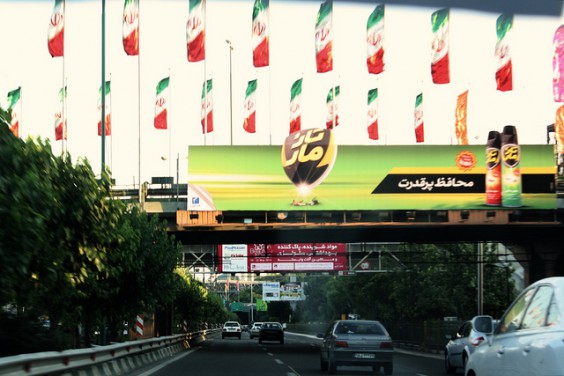An Art Gallery as Large as a City
by Yaghoub Yadali and translated by Parvaneh Torkamani / May 29, 2015 / No comments

Advertisements on billboards in Tehran were replaced with works by old masters and Iranian artists. Photo via Flickr user: Blondinrikard Fröberg.
Art replacing advertisements on billboards across Tehran proves that culture can be a unifying force in a city often divided over politics and ideology.
As the people of Tehran left their homes to go to work on the morning of May 5, instead of seeing advertisements for food, clothes, shoes and cars on the commercial billboards across town they faced huge copies of paintings by famous artists from Iran and around the world! At first, this scene must have been confusing to the city dwellers.

- “Enemy…terrorism…nuclear bomb…war.” These words are often used by American media to describe Iran. The image the media presents is often hazy, incomplete, and distorted. The political and military aspects of my country are covered mainly in a negative light.
- In Under Eastern Eyes (I have adopted the name from the novel Under Western Eyes by Joseph Conrad), I will write about those topics which American media either cannot or does not want to talk about. The emphasis will be on social and cultural aspects of Iran although, out of necessity, I will talk about politics, despite my despair.

- Yaghoub Yadali, born in 1970, is a writer and television director. His first work of fiction, the short-story collection Sketches in the Garden, was published in 1997. It was followed in 2001 by Probability of Merriment and Mooning, which was named book of the year by the Writers and Critics Award. His first novel, The Rituals of Restlessness, won the 2004 Golshiri Foundation Award for the best novel of the year and was named as one of the ten best novels of the decade by the Press Critics Award. He has also published many articles and reviews of literature and cinema in newspapers and magazines in Iran.
Within a few hours everyone was talking about the unusual creativity of Tehran’s city hall, which had decided to dedicate all of the city’s billboards to art and culture in conjunction with the Tehran International Book Fair, which was occurring from May 5-15. Private companies who rented the billboards made their space accessible for this project at no charge. For ten exceptional days there were no advertisements for sandwiches, chips, drinks, shoes, or cars. Personally, I don’t remember an event of such dimension happening in any other city or country.
Altogether, 500 works by Iranian artists and 200 by old masters were exhibited on about 1500 billboards across Tehran. Among the artists, one could view works by Picasso, Matisse, Van Gogh, Monet, Rembrandt, Cézanne, and Miro.
This event had a large national feedback. Not only did newspapers, websites, and cultural circles talk about it, but people who may have never entered an art gallery before also spoke favorably about the event, with good feeling. Except for special occasions – such as when a favorite sports team wins – this is something that does not happen. In fact, the move by Tehran’s City Hall led to a unified wave of attention and familiarity with international works of art.
Internationally, the event also had a large amount of feedback. Reaction was so wide and positive that the city hall opened a permanent office for the project, called “A Gallery as Large as a City,” so that the project can be implemented in a more complete and optimized way in future years.
This event showed that art and culture can be an element of unity in a society like Iran’s and could make everyone cooperate actively, devoid of political motivations or ideology.




